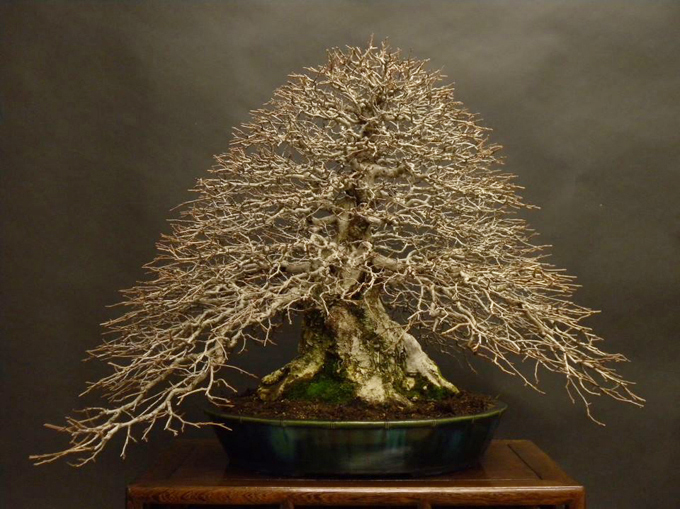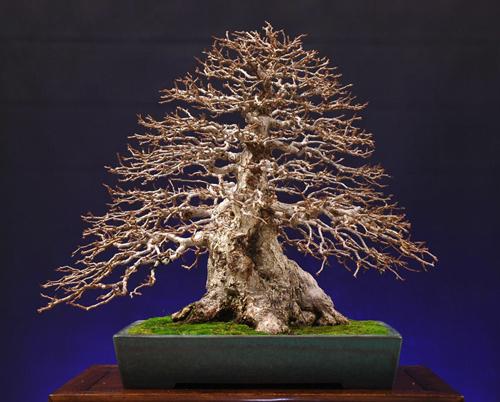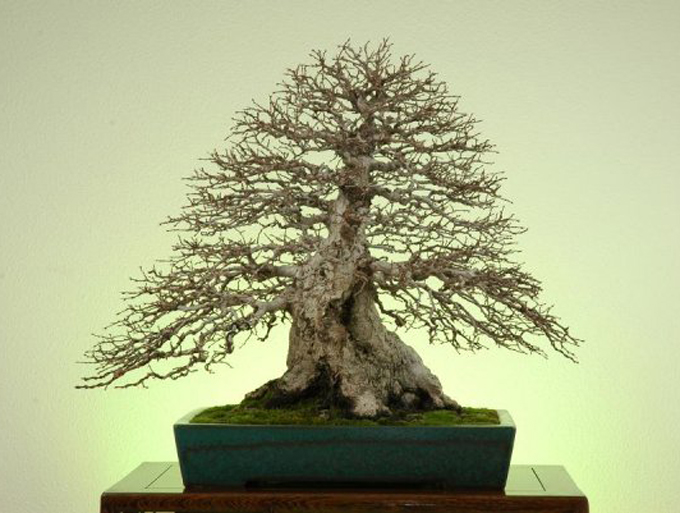 An exercise in extreme ramification. Mario Komsta’s latest photo of his now famous Hornbeam (Carpinus laxiflora). The three photos below are earlier stages of the same tree. All have been featured on Bonsai Bark and at least two in Mario’s facebook photos.
An exercise in extreme ramification. Mario Komsta’s latest photo of his now famous Hornbeam (Carpinus laxiflora). The three photos below are earlier stages of the same tree. All have been featured on Bonsai Bark and at least two in Mario’s facebook photos.
Fine ramification can be the difference between average and exceptional bonsai
The photos in this post provide a chronology of a Hornbeam that belongs to Mario Komsta. Though there is much to say about this magnificent bonsai, it’s the fine ramification (branching) that I find the most compelling (taking absolutely nothing away from the trunk’s stupendous base).
In case you’re not familiar with the whole notion of ramification, it goes something like this: the heavy branches that come directly off the trunk are called main or primary branches. The branches that come off the primary branches are called secondary branches. The branches that come off of the secondary branches are called tertiary branches. The branches that come off the tertiary branches are be called quaternary branches (aka twigs) and so forth. The object is to develop these various branch layers, each finer than the previous.
When done well, ramification lends a feeling of maturity and depth to a tree. Unfortunately, you don’t see that many bonsai with highly developed ramification, at least here in the West. I think this is mostly about the time and patience it takes to develop highly refined branching. Once the bones (the trunk and the primary branching) of a bonsai are established it takes at least a year, in most cases, to develop each subsequent layer of ramification.
It also takes skill to develop good ramification. This has a lot to do with knowing what to prune and what to leave; removing branching that is too coarse, so that each layer is noticeably finer than the previous layer. This creates continuous taper from the base of the trunk along any line you chose to follow, out to the finest new twigs.
 This photo appeared on Bonsai Bark exactly two years ago (December 2010). Like the other two, it was originally from Mario’s facebook photos.
This photo appeared on Bonsai Bark exactly two years ago (December 2010). Like the other two, it was originally from Mario’s facebook photos.
 This more profession grade photo appeared in Bonsai Bark in October 2010. It originally appeared on Mario’s website which seems to have disappeared (for many, it’s all about facebook these days). It’s hard to tell for sure, but it looks like it was taken just after the version in the photo below had been lightly pruned and cleaned up.
This more profession grade photo appeared in Bonsai Bark in October 2010. It originally appeared on Mario’s website which seems to have disappeared (for many, it’s all about facebook these days). It’s hard to tell for sure, but it looks like it was taken just after the version in the photo below had been lightly pruned and cleaned up.
 This photo appeared in Mario’s facebook photos three years ago (January 2010), though I suspect it’s from earlier, perhaps the winter of 2009?
This photo appeared in Mario’s facebook photos three years ago (January 2010), though I suspect it’s from earlier, perhaps the winter of 2009?
Hrm. Not good ramification at all. That’s just long branches/shoots. The last (bottom) photo shows far better and more artful ramification. And I’m not making any value judgments regarding the respective silhouettes. Ramification means something. The first (top) photo shows a poor level of it.
Emphasis is a useful artistic tool. But emphasis alone conveys no measure of quality.
True, the last photo shows finer twigs than the first one. That might be due to the lens, focal distance, etc. Then again, it might not. Maybe the owner, wanting to take shortcuts, had the tree overgrown before he pruned it. Never a good idea. Then again, it could just be me: I never liked that hippie look. It doesn’t suit this tree. I’d seriously rarefy ;-) the canopy. Especially the lower part.
Nice tree. Is the apex facing the right direction?
Andy, there is ramification there, it is just obscured by the long terminal internodes. I agree that the October 2010 Bonsai Bark photo is a much better representation and a cleaner bonsai. The top photo looks like it is trying to decide whether to be a semi-cascade mustache or an upright – and leaning toward the mustache. Branches appear to be below the pot rim on both sides. I hope that is just due to an unfortunate camera angle but the obscured layering and over grown bushiness is not appealing.
Rod Stewart!
Andy, it’s always funny to read your comments! It makes me laugh a lot. Are you doin’ better?
Hi Wayne
Is there a chance of uploading a picture of the tree in full leaf?
I’m not a lover of Facebook.
Regarding the other two comments, Id ignore them as I would be proud to own it!
JC
Hi Andy, Zack, Colin and friends,
My guess is that Mario has decided to see just how far he can go with the branching on this particular tree (emphasis as Andy says). I wouldn’t be surprised if he shows it in a few years with the fine branches reaching all the way down to the floor.
While the current image isn’t my favorite tree, I think the arching boughs make this hornbeam unique. What was a typical Japanese pine style showing great craftsmanship, to my eye, now has a story explaining its branches below the horizontal, drooping from the great weight of the extended branching(I bet it looks great with the hop-like flowers hanging from those weeping branches too).
although the branches on the lower third of the tree do not conform to standard bonsai practices, I think they represent a less conforming, more naturalistic approach to viewing the growth of a particular species
It’s my belief that the top photo looks as though Mario was trying to thicken the lower branches
a bit, while the last two photos represent where Mario brought the branches into their correct
proportions by pruning the branches closer to the trunk, and of course look more proper
in relation to the trunk.
As a side comment, I’m not a fan of pine tree shaped Carpinus or any deciduous tree for that matter..
Have you ever seen one shaped like this in nature? Wonderful ramification though.
Thanks Gary,
Good observations. I think the problem (if it could be said to be a problem) with the tree at the bottom is that the lower branches extend below the soil line, which creates an unnatural look. Still, it is a truly fantastic tree with ramification that few people, outside of Japan anyway, bother with.